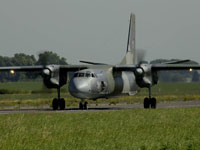|

|
|

|
The An-26
is a development of An-24. One of the main modifications was a rear
loading ramp.
More than 1,100 of this versatile transport aircraft were built before
production ended in 1978. The An-26, has many of the same features as
the An-24.
The An-26 by Antonov is designed for tactical transport of passengers
and material on short and medium distances.
It has a large rear loading ramp to facilitate loading of cargoes. The
engines are more powerful in comparison with the An-24. A pressurised
cabin makes it possible to fly at high levels.
It has fairly modern navigation and communication devices, an ADF
automatic radio direction finder, DME distance measuring system,
marker and ILS/GS instrument landing system, and a radio altimeter.
The avionics and instrumentation permits all-weather operation and
safe landing. The An-26Z version is fitted with special devices and
instrumentation for air reconnaissance and control of combat
activities.
After successful operations of the An-24T tactical transport in
austere locations, interest in a version with a retractable cargo
ramp increased. Initial studies for the retractable ramp were
carried out as part of the projected An-40 medium transport. When
given the go-ahead for the An-26 in March 1968 the Antonov OKB
adapted the ramp design of the An-40 to the An-24 fuselage, thus was
born the An-26. Particular attention was given to the military
mission and the majority of early An-26 production was delivered to
the VT-A.
Using the majority of the An-24 airframe, with its high-set
cantilevered wings, twin turboprops and stalky main undercarriage,
the An-26 included military equipment, such as tip-up paratroop
canvas seats, overhead travelling hoist, bulged observation windows
and parachute static line attachment cables. The An-26 made its
public debut at the 27th Paris Air Show at Le Bourget where the
second prototype, CCCP-26184 (c/n00202), was shown in the static
aircraft park.
|
AN-26 Specifications |
|
Type |
Tactical
transport |
|
Manufacturer |
Antonov |
|
Accommodation |
Two pilots, flight
engineer, navigator, radio operator, plus loadmaster. Seating for up to 40
troops or 24 stretcher patients |
|
Armament |
None |
|
Performance |
Cruising speed 275mph
(440km/h) |
|
Wing Span |
95ft 9in (29.2m) |
|
Length |
78ft 1in (23.8m) |
|
Height |
27ft 3in (8.32m) |
|
Weight |
payload 12,000lb
(5,500kg), weight empty 33,110lb (15,020kg) |
|
Powerplant |
Two Progress AI-24VT
turboprops, 2,820 shp (2,100 kW) each |
|